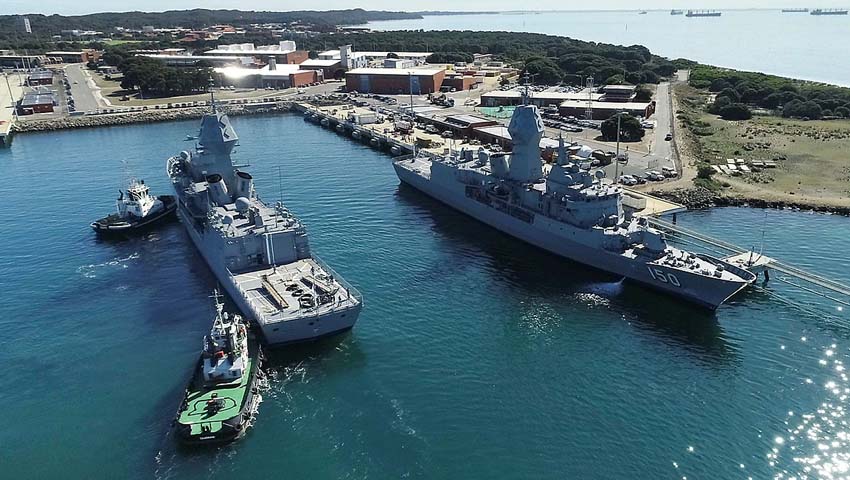The Royal Australian Navy’s frigate HMAS Anzac has joined HMAS Arunta as the second of the fleet’s Anzac Class frigates to undergo the Anzac Midlife Capability Assurance Program (AMCAP) upgrade.
To continue reading the rest of this article, please log in.
Create free account to get unlimited news articles and more!
HMAS Anzac recently sailed to her homeport of Fleet Base West, Garden Island, Western Australia, where she was joined by her sister ship HMAS Arunta, which completed the program, known as AMCAP, in 2019.
Frigate Group Capability Manager’s Representative, Captain Dugald Clelland, said AMCAP represented a major milestone in the operational life of Navy’s Anzac Class frigates.
CAPT Clelland explained, "AMCAP consists of three major elements, the most striking is the new air search radar that visually differentiates a post-AMCAP ship from its pre-upgrade counterparts.
"The Project SEA 1448 Phase 4B component of the upgrade improves the Anzac Class Air Search capability by replacing the ageing AN/SPS-49 long range air search radar with a new digital phased array radar developed by Australian company CEA Technologies."
SEA1448 Phase 4B is replacing the SPS-49(V)8 Air Search Radar on the 8 Anzac class frigates with a modern phased array radar.
This project showcases Australian design and integration capability with the new Phased Array Radar technology designed by CEA Technologies in Canberra in conjunction with upgrades to combat systems performed by Saab Systems in South Australia and platform integration design by BAE Systems in Victoria.
Installation of this capability will coincide with the AMCAP. The aim of AMCAP is to upgrade and update the capability of the Anzac Class frigates to maintain relevance, and to ensure the class remains effective until the introduction of the Hunter Class frigates.
"The aim of AMCAP is to ensure our frigates remain at the forefront of regional surface combatant capability until the new Hunter Class frigate is introduced into service later this decade," CAPT Clelland said.
The PSR will see the upgrade of systems such as propulsion control, fridges, waste management and water production.
Anzac’s Commanding Officer, Commander Brendan Horn said after an 81-week maintenance and upgrade period, he and his ship’s company were happy to be back at Fleet Base West.
"Anzac is really well placed to complete sea trials and return to the fleet as an operational ship. I’m extremely proud of the crew and I know everyone is enthusiastic about getting back to sea," CMDR Horn said.
CAPT Clelland said the AMCAP, which comes after the Anzac Class frigates underwent the Anti-Ship Missile Defence program, was a complex task that required close co-operation between Navy and its key partners.
"The successful completion of the second AMCAP is a significant achievement for Navy, Capability Acquisition and Sustainment Group, and industry, and will ensure this class of ship remains lethal for years to come," CAPT Clelland explained.
The WAMA partnership was launched in 2016 to support the Anzacs and includes BAE Systems Australia, Saab Australia, Naval Ship Management and the Commonwealth of Australia. It’s worth more than $2 billion over eight years.
The Henderson-based Australian Marine Complex (AMC) is integral to Australia’s frontline defence and is an important asset in maintaining the RAN fleet. The Common User Facility (CUF) has facilitated major works and repair programs for RAN’s Collins Class submarines, Anzac Class frigates and supply tankers.
The AMC-CUF is home to the world’s most technically advanced floating dock, which can lift vessels of up to 12,000 tonnes out of the water for service. Its four wharves can accommodate vessels of up to 300 metres in length and provide adequate berthing space for major works, including ship conversions, refits and repairs.
The AMC-CUF is also home to ASC West, which provides a purpose-built submarine repair facility and the WA headquarters of ASC, an Australian-owned prime defence contractor and builder of the Collins Class submarine and Hobart Class air warfare destroyer.
ASC’s through-life support contract will see the Collins Class submarines maintained at the CUF over the next 25 years. Warfare systems developer Raytheon Australia and other defence contractors, including BAE Systems, also reside within the AMC’s precincts.

 Login
Login







